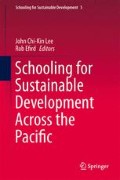Abstract
In 2003 China’s Ministry of Education mandated the infusion of environmental education in all classes at all levels of China’s elementary and secondary public schooling. However, this mandate has collided with deeply entrenched structural obstacles in China’s school system and remains largely unfulfilled. In particular, a widespread preoccupation with test scores and student safety discourages teachers from devoting class time to environmental education content, and severely inhibits attempts to engage students in the type of hands-on learning specifically recommended in the Ministry of Education’s guidelines for environmental education practice. This chapter draws upon interviews with elementary school teachers and fieldwork with an environmental NGO in the city of Kunming in China’s Yunnan Province to analyze this enduring gap between policy and practice.
Access this chapter
Tax calculation will be finalised at checkout
Purchases are for personal use only
References
Efird, R. (2010). Guest Editor’s introduction: NGOs and institutions of higher education in China’s environmental learning. Chinese Education and Society, 43(2), 3–5.
Efird, R. (2011). Learning by heart: An anthropological perspective on environmental learning in Lijiang. In H. Kopnina & E. Shoreman-Ouimet (Eds.), Environmental anthropology today. New York: Routledge.
Efird, R. (2012). Learning the land beneath our feet: The place of NGO-led environmental education in Yunnan province. Journal of Contemporary China, 21(76).
Fong, V. (2006). Only hope: Coming of age under China’s one child policy. Palo Alto: Stanford University Press.
Gruenewald, D., & Manteaw, B. (2007). Oil and water still: How No child left behind limits and distorts environmental education in U.S. schools. Environmental Education Research, 13(2), 171–188.
Guang, Y., & Lam, C. C. (2009). ESD in Chinese secondary schools: Beijing teachers’ views. Geography, 94(1), 22–27.
Kipnis, A. (2011). Governing educational desire: Culture, politics, and schooling in China. Chicago: University of Chicago Press.
Lee, J. C. K. (2007). Environmental Educators’ Initiative (EEI) final evaluation report. Beijing: WWF-Beijing Office.
Lee, J. C. K. (2010). Education for sustainable development in China: Experiences of the environmental educators’ initiative. Chinese Education and Society, 43(2), 65–83.
Lee, J. C. K., & Tilbury, D. (1998). Changing environments: The challenges for environmental education in China. Geography, 83(3), 227–236.
Lee, J. C. K., & Huang, Y. (2009). Education for sustainable development projects and curricular reform in China: The EEI and the EPD. In J. C. K. Lee & M. Williams (Eds.), Schooling for sustainable development in Chinese communities: Experience with younger children (pp. 115–136). Dordrecht: Springer.
Lee, J. C. K., & Williams, M. (2009). Schooling for sustainable development in Chinese communities: Experience with younger children. Dordrecht: Springer.
Lin, J., & Ross, H. (2005). Addressing urgent needs: The Emergence of environmental education in China. China Environment Series 7, 74–78. Retrieved November 12, 2012, from http://www.wilsoncenter.org/sites/default/files/chinaenv7.pdf
Louv, R. (2005). Last child in the woods. Chapel Hill: Algonquin Books.
Ma, G. X. (2007). Environmental education (2nd ed.). Beijing: Science Publishing (in Chinese).
Ma, G. X. (2010). The practice and idea of environmental education at normal colleges and universities. Chinese Education and Society, 43(2), 53–62.
Ministry of Education. (2003a). Guide for implementing primary and secondary environmental education (trial) (in Chinese). Beijing: Ministry of Education.
Ministry of Education. (2003b). Special topic: Education outline for primary and secondary school children’s environmental education. Beijing: Ministry of Education.
Shapiro, J. (2012). China’s environmental challenges. Boston: Polity.
Smith, G. A., & Sobel, D. (2010). Place- and community-based education in schools. New York: Routledge.
Stevenson, R. (2007). Schooling and environmental/sustainability education: From discourses of policy and practice to discourses of professional learning. Environmental Education Research, 13(2), 265–285.
Watts, J. (2010). When a billion Chinese jump. New York: Scribner.
Wu, Z. Q. (2002). Green schools in China. The Journal of Environmental Education, 34(1), 21–25.
Yang, G. B. (2009). Civic environmentalism. In Y. T. Hsing & C. K. Lee (Eds.), Reclaiming Chinese society (pp. 120–140). London/New York: Routledge.
Zeng, H. Y., Guang, Y., & Lee, J. C. K. (2009). Green schools in China. In J. C. K. Lee & M. Williams (Eds.), Schooling for sustainable development in Chinese communities: Experience with younger children (pp. 137–156). Dordrecht: Springer.
Acknowledgements
The research for this article was conducted under the auspices of a Fulbright Senior Research Scholar grant (2011–2012), for which the author is deeply grateful.
Author information
Authors and Affiliations
Corresponding author
Editor information
Editors and Affiliations
Rights and permissions
Copyright information
© 2014 Springer Science+Business Media Dordrecht
About this chapter
Cite this chapter
Efird, R. (2014). Closing the Green Gap: Policy and Practice in Chinese Environmental Education. In: Lee, JK., Efird, R. (eds) Schooling for Sustainable Development Across the Pacific. Schooling for Sustainable Development, vol 5. Springer, Dordrecht. https://doi.org/10.1007/978-94-017-8866-3_15
Download citation
DOI: https://doi.org/10.1007/978-94-017-8866-3_15
Published:
Publisher Name: Springer, Dordrecht
Print ISBN: 978-94-017-8865-6
Online ISBN: 978-94-017-8866-3
eBook Packages: Humanities, Social Sciences and LawEducation (R0)

